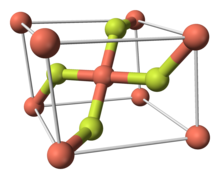Copper(II) fluoride

| |

| |

| |

| |
| Names | |
|---|---|
| IUPAC name
Copper difluoride
| |
| Other names
Cupric fluoride; Copper fluoride
| |
| Identifiers | |
3D model (JSmol)
|
|
| ChemSpider | |
| ECHA InfoCard | 100.029.225 |
PubChem CID
|
|
CompTox Dashboard (EPA)
|
|
| |
| |
| Properties | |
| CuF2 | |
| Molar mass | 101.543 g/mol (anhydrous) 137.573 g/mol (dihydrate) |
| Appearance | White crystalline powder When hydrated: Blue |
| Density | 4.23 g/cm3 (anhydrous) 2.934 g/cm3 (dihydrate)[1] |
| Melting point | 836 °C (anhydrous) 130 °C (dihydrate, decomposes) |
| Boiling point | 1676 °C (anhydrous) |
| Solubility in other solvents | Hygroscopic |
| Related compounds | |
Other anions
|
Copper(II) bromide Copper(II) chloride |
Other cations
|
silver(II) fluoride cobalt(II) fluoride |
Except where otherwise noted, data are given for materials in their standard state (at 25 °C [77 °F], 100 kPa).
| |
Copper(II) fluoride is an inorganic compound with the chemical formula CuF2. It is a white or green, crystalline, hygroscopic solid. It has a rutile-type crystal structure similar to other fluorides of chemical formulae MF2.
Uses
It has been shown that aromatic hydrocarbons react with copper(II) fluoride, in an oxygen-containing atmosphere at temperatures above 450 °C, to form fluorinated aromatic hydrocarbons. This reaction is simpler than the Sandmeyer reaction, but is only applicable for compounds which are stable enough to survive the high temperature.[2]
Chemistry
Copper fluoride can be synthesised from copper and fluorine at temperatures of 400 °C.
- Cu + F2 → CuF2
It loses fluorine in molten stage at temperatures above 950 °C.
- 2CuF2 → 2CuF + F2
- 2CuF → CuF2 + Cu
The complex anions of CuF3−, CuF42− and CuF64− are formed if CuF2 is exposed to substances containing fluoride ions F−.
References
- C. Billy, H. M. Haendler (1957). "The Crystal Structure of Copper(II) Fluoride". Journal of the American Chemical Society. 79: 1049–51. doi:10.1021/ja01562a011.
- P. C. de Mello, M. Hehenberg, S. Larson, M. Zerner (1980). "Studies of the electronic structure of copper fluorides and copper chlorides". Journal of the American Chemical Society. 102: 1278–1288. doi:10.1021/ja00524a010.
{{cite journal}}: CS1 maint: multiple names: authors list (link) - H. M. Haendler, L. H. Towle, E. F. Bennett, W. L. Patterson (1954). "The Reaction of Fluorine with Copper and Some of its Compounds. Some Properties of Copper(II) Fluoride". Journal of the American Chemical Society. 76: 2178–2179. doi:10.1021/ja01637a039.
{{cite journal}}: CS1 maint: multiple names: authors list (link) - T. C. Ehlert, J. S. Wang (1977). "Thermochemistry of the copper fluorides". Journal of Physical Chemistry. 81: 2069–2073. doi:10.1021/j100537a005.
External links
- National Pollutant Inventory - Copper and compounds fact sheet
- National Pollutant Inventory - Fluoride and compounds fact sheet

